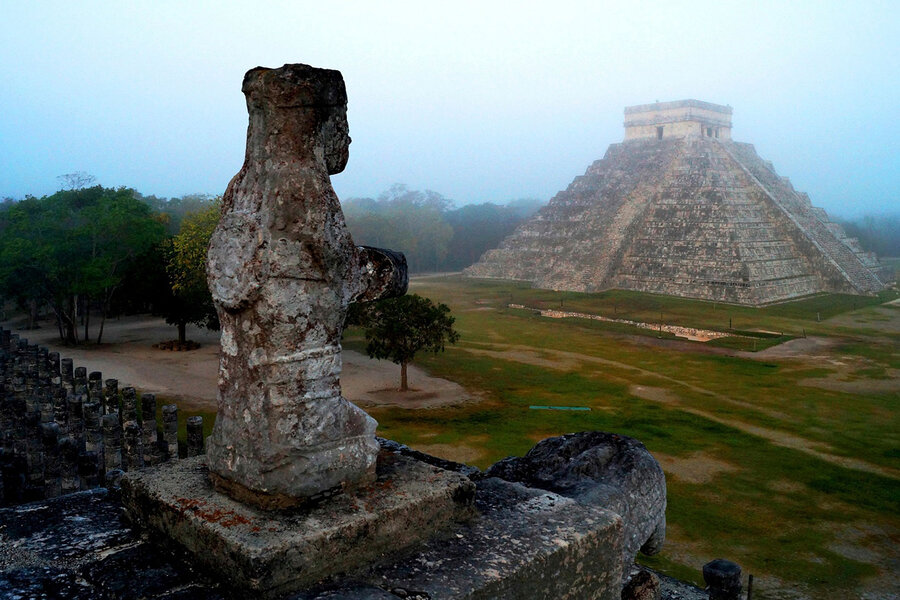How Canadian teenager used space archaeology in hunt for lost Mayan city
Loading...
A 15-year-old archaeologist has created a celestial building plan of one of Latin America's ancient civilizations using satellite images and star charts in a dramatic demonstration of the latent promise – and limits – of "space archaeology."
From his home in Quebec, William Gadoury had pored over constellation charts and maps of Mayan geography in Latin America, as the Journal de Montreal reported. The alignment of heavenly bodies with temples or complexes on a site is well-established, but William hypothesized the Mayans had lined up an entire complex of cities with the stars.
"I did not understand why the Maya built their cities away from rivers, on marginal lands and in the mountains," William told Journal de Montreal. "They had to have another reason, and as they worshiped the stars, the idea came to me to verify my hypothesis. I was really surprised and excited when I realized that the most brilliant stars of the constellations matched the largest Maya cities."
William used his map, which covers parts of Mexico, Guatemala, and Belize, to predict the location of an undiscovered city. Based on satellite images he obtained through NASA, JAXA (Japan's Space Agency) and the Canadian Space Agency, he believes he found a city he is calling K’àak’ Chi’ or "fire mouth," Samuel Osborne wrote for the Independent. William hopes to visit the site in Belize someday to properly explore the hypothesis.
Charles Golden, an anthropologist who specializes in Mayan archaeology, applauded William's creative use of new technology to explore the area, but he urged caution in claiming discovery before the fieldwork has verified it.
"It's an extraordinary claim that requires extraordinary evidence to back it up," Dr. Golden tells The Christian Science Monitor in a phone interview. "It requires a belief that over a period of hundreds of years, people across various areas communicated with one another, and there's just no evidence to date that this is the case."
Archaeologists say such technology-aided findings are likely to continue as technology improves and higher-resolution images become available, but suggest guidelines that would reflect new advancements in technology while maintaining the integrity of fieldwork.
Visiting the site is critical to proving the claim, Golden says. Having performed his own "space archaeology" research with help from NASA, Golden doubts radar could penetrate the dense jungle enough to prove a city's existence. He pointed to the work of 2016 TED award winner and Egyptologist Sarah Parcak, which has brought more attention recently to "space archaeology," as an example of how this new technology can be employed to advance archaeology – use the airplane or satellite images to identify a clue, then verify the hypothesis using fieldwork.
"Even with the best of technologies, nothing replaces groundwork," Golden says. "Archaeology can be very exciting, and the fact that it is science that needs to be tested like any other science can be lost."
Archaeologists should establish ethical guidelines for remote sensing or "space archaeology," says Douglas Comer, an archaeologist who specializes in satellite technology and president of ICOMOS International Scientific Committee on Archaeological Heritage Management. He compared remote sensing technology to carbon-14 dating in its potential to alter the field.
"It's a tool, and we have to learn how to apply this tool,” Dr. Comer tells The Christian Science Monitor in a phone interview.
Comer praised William's creative approach to Mayan archaeology, but he says archaeologists excited by the promise of remote technology are pondering the question: Is it fair, or even accurate, for a researcher to claim a discovery without the decades of study, negotiations with local governments, sunburn and blisters archaeology traditionally demands?
"I don't think we'd feel comfortable saying we've discovered these things [without visiting the sites], we just happened to know how to use the technology," Comer says. "It's not fair to somebody who's worked their entire career in an area and worked it backwards and forwards."
Using the new technology to claim discovery without verification through fieldwork risks discrediting the technology just as its value is becoming more apparent, Comer says.
"Technology is a double-edged sword," Comer says. "The dangers that are involved with it are worth it, certainly, but we need to think about it."








